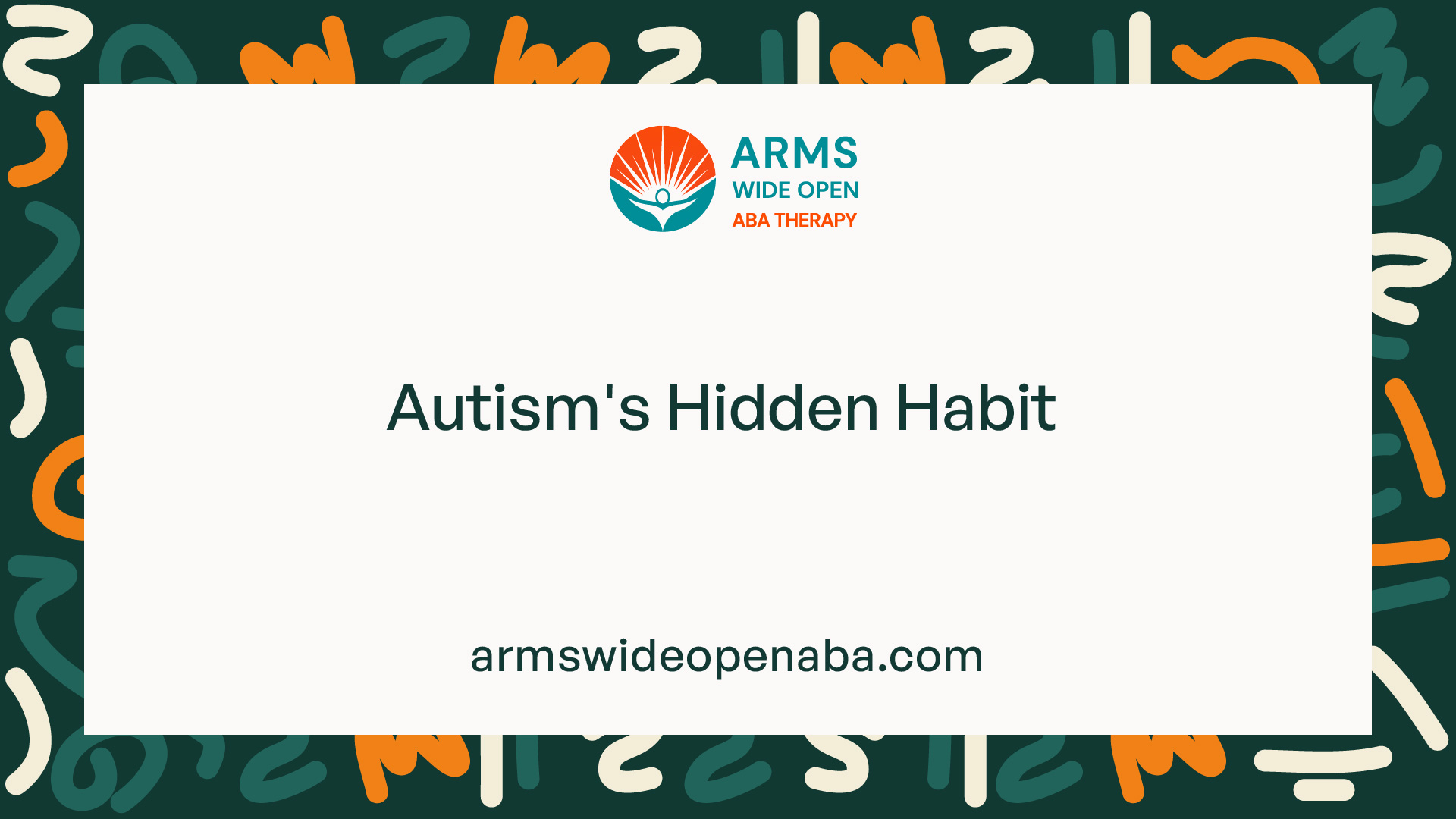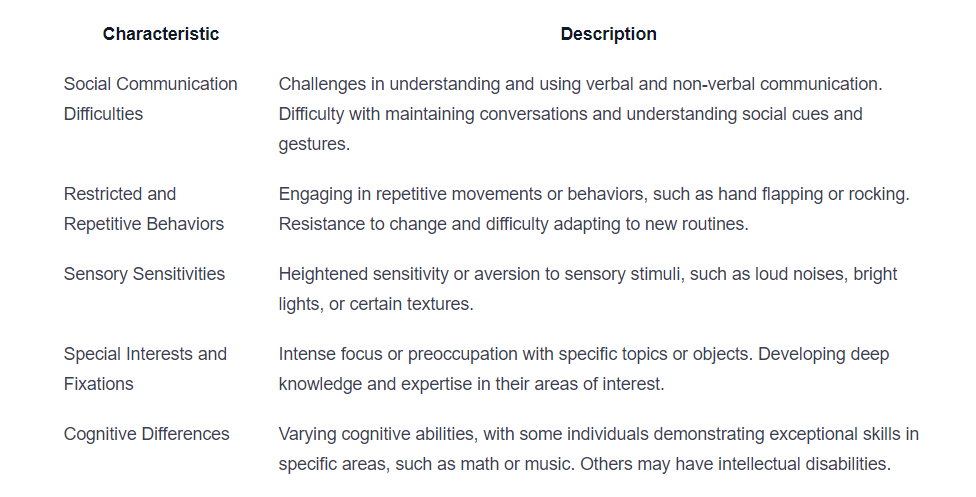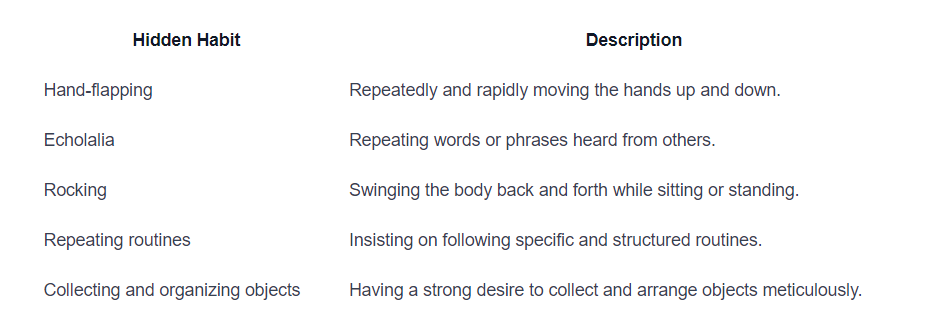Autism's Hidden Habit
Unraveling the mysteries of autism's hidden habits. Discover the impact and strategies for understanding and supporting individuals.

Understanding Autism
To decode the hidden habit associated with autism, it is essential to first gain an understanding of what autism is and the common characteristics associated with it.

What is Autism?
Autism, also referred to as Autism Spectrum Disorder (ASD), is a neurodevelopmental disorder that affects communication, social interaction, and behavior. It is a spectrum disorder, meaning that it encompasses a wide range of symptoms and abilities.
Individuals with autism may experience challenges in social interaction, communication, sensory processing, and exhibit repetitive behaviors. It is important to note that autism is not a disease or a condition that can be "cured," but rather a different way of perceiving and experiencing the world.
Common Characteristics of Autism
Autism manifests in various ways, and individuals with autism may exhibit a range of characteristics. While each person with autism is unique, there are common characteristics that are often observed. These include:

It is important to recognize that these characteristics can present differently in each individual with autism. The spectrum nature of autism means that individuals may have a combination of strengths and challenges that are unique to them.
By understanding the essence of autism and the common characteristics associated with it, we can begin to unravel the enigma behind the hidden habit that individuals with autism may exhibit.
Unveiling the Hidden Habit
Understanding autism requires us to delve into the realm of autistic behaviors, including the concept of hidden habits. These hidden habits are unique to individuals on the autism spectrum and can manifest in various ways. Let's explore autistic behaviors and uncover the enigma behind hidden habits.
Exploring Autistic Behaviors
Autistic behaviors encompass a wide range of characteristics and actions exhibited by individuals on the autism spectrum. These behaviors can be observable, such as repetitive movements or atypical social interactions, or they can be hidden, known as hidden habits. Understanding and recognizing these behaviors is essential for providing support and fostering a more inclusive environment.
The Concept of Hidden Habits
Hidden habits refer to the behaviors and actions that individuals on the autism spectrum engage in, often in a repetitive or ritualistic manner. These habits may not be immediately apparent to others, making them challenging to detect and understand. Hidden habits can serve various purposes for individuals with autism, from self-regulation and sensory stimulation to reducing anxiety and providing a sense of comfort.
To gain a better understanding of hidden habits, it's important to recognize that they can take different forms. Some common examples include:

It's crucial to approach hidden habits with empathy and without judgment. Recognizing that these habits serve a purpose for individuals with autism allows us to create a more inclusive and supportive environment. By understanding the underlying reasons behind these habits, we can provide appropriate strategies and accommodations to help individuals on the autism spectrum thrive.
Unveiling the hidden habits within autism is a crucial step toward fostering understanding and acceptance. By exploring autistic behaviors and acknowledging the concept of hidden habits, we can build a more inclusive society that embraces and supports individuals with autism.
Types of Hidden Habits
Autism is a complex neurodevelopmental disorder that manifests in a variety of ways. One aspect of autism that is often misunderstood is the presence of hidden habits. Hidden habits are behaviors and preferences that are unique to individuals with autism and may not be immediately apparent to others. Understanding these hidden habits is essential for providing appropriate support and fostering inclusivity. Let's explore three common types of hidden habits: repetitive behaviors, sensory sensitivities, and special interests and fixations.
Repetitive Behaviors
Repetitive behaviors are a hallmark of autism and can take various forms. These behaviors serve different purposes for individuals with autism, such as self-soothing, reducing anxiety, or maintaining predictability. Some common examples of repetitive behaviors include:
- Stimming: Stimming refers to self-stimulatory behaviors that involve repetitive movements or actions, such as hand-flapping, rocking, or spinning. These behaviors help individuals with autism regulate their sensory experiences and cope with overwhelming stimuli.
- Rituals and Routines: Many individuals with autism rely on specific rituals and routines to navigate their daily lives. These rituals may involve following a strict schedule or performing tasks in a particular order. Deviating from these routines can cause distress and anxiety.
Understanding and respecting these repetitive behaviors is crucial for creating an inclusive environment that accommodates the unique needs of individuals with autism.
Sensory Sensitivities
Sensory sensitivities are commonly experienced by individuals with autism. They can be hypersensitive (over-responsive) or hyposensitive (under-responsive) to different sensory stimuli. This heightened or diminished sensitivity can impact their perception and reaction to sensory information. Some examples of sensory sensitivities include:
- Auditory Sensitivity: Individuals with autism may be hypersensitive to certain sounds, such as loud noises or high-pitched sounds. These sounds can be overwhelming and cause significant distress or discomfort.
- Tactile Sensitivity: Tactile sensitivity refers to heightened sensitivity to touch. Individuals with autism may be sensitive to certain textures, clothing fabrics, or tactile sensations, leading to discomfort or aversion.
Understanding these sensory sensitivities and making necessary accommodations, such as providing a quiet space or using soft fabrics, can help create a more inclusive environment for individuals with autism.
Special Interests and Fixations
Many individuals with autism develop intense, highly focused interests known as special interests or fixations. These interests can be in a wide range of subjects, from trains and dinosaurs to math or art. Special interests often provide individuals with autism a sense of joy, purpose, and expertise. Some key features of special interests include:
- Intense Knowledge: Individuals with autism often display an exceptional depth of knowledge and expertise in their areas of interest. They may be able to recall specific details or facts with remarkable accuracy.
- Passion and Engagement: Special interests provide individuals with autism a sense of purpose and engagement. They may spend significant amounts of time researching, collecting, or engaging in activities related to their interests.
Supporting individuals with autism involves respecting and encouraging their special interests while also providing opportunities for social interaction and diversification of activities.
Understanding the different types of hidden habits associated with autism is crucial for promoting inclusivity and providing appropriate support. By recognizing and accommodating repetitive behaviors, sensory sensitivities, and special interests, we can create a more understanding and supportive environment for individuals with autism.
Impact on Daily Life
Individuals with hidden habits related to autism face unique challenges that can impact their daily lives. Understanding these challenges and providing appropriate support is essential for creating an inclusive and supportive environment.
Challenges Faced by Individuals with Hidden Habits
Autistic individuals with hidden habits may encounter various challenges that affect their daily lives. Here are some common difficulties they may face:
- Social Interaction: Hidden habits can sometimes interfere with social interactions, making it challenging for individuals to engage in typical social exchanges or understand nonverbal cues.
- Communication: Autistic individuals may experience difficulties expressing themselves or understanding others due to their hidden habits. This can lead to misunderstandings and frustration.
- Self-Regulation: Managing hidden habits can be overwhelming, and individuals may struggle with self-regulation, leading to emotional outbursts or meltdowns in certain situations.
- Sensory Overload: Many individuals with hidden habits experience sensory sensitivities, making them more susceptible to sensory overload. This can result in discomfort or distress in environments with excessive noise, bright lights, or strong smells.
- Routine Disruption: Hidden habits often involve a strong attachment to routines and predictability. Any disruptions to these routines can cause distress and anxiety for individuals with hidden habits.
Coping Mechanisms and Support Systems
To navigate the challenges associated with hidden habits, individuals with autism often develop coping mechanisms and rely on support systems. These strategies can help them better manage their hidden habits and lead fulfilling lives. Here are some examples:
- Self-Calming Techniques: Autistic individuals may develop various self-calming techniques, such as deep breathing exercises, mindfulness practices, or sensory tools like fidget toys, to cope with stress or sensory overload.
- Visual Supports: Visual supports, such as visual schedules or social stories, can help individuals with hidden habits understand and navigate daily routines, social situations, and expectations.
- Therapies and Interventions: Different therapies and interventions, such as behavioral therapy or occupational therapy, can provide individuals with strategies to manage hidden habits and develop essential life skills.
- Supportive Environment: Creating a supportive environment is crucial for individuals with hidden habits. This includes providing a predictable and structured routine, minimizing sensory triggers, and fostering understanding and acceptance from family, friends, and the community.
- Support Networks: Building a strong support network is beneficial for both individuals with hidden habits and their caregivers. Support groups, online communities, and organizations dedicated to autism can provide valuable resources, advice, and a sense of belonging.
Understanding the challenges faced by individuals with hidden habits and implementing suitable coping mechanisms and support systems can make a significant difference in their daily lives. By fostering empathy, acceptance, and inclusivity, we can create a more supportive and accommodating society for individuals with hidden habits related to autism.
Strategies for Understanding and Supporting
Supporting individuals with hidden habits associated with autism requires a compassionate and empathetic approach. By building awareness, communicating effectively, and providing a safe and understanding environment, we can create a supportive framework for individuals with autism and their loved ones.
Building Awareness and Empathy
Building awareness about autism and hidden habits is crucial in fostering understanding and acceptance. Educating oneself and others about the challenges faced by individuals with autism can help break down stigmas and misconceptions.
Strategies for Building Awareness and Empathy
Educate yourself about autism and hidden habits through reliable sources such as books, articles, and credible websites.
Attend workshops, seminars, or webinars on autism to gain insights and knowledge.
Engage in discussions with individuals who have personal experiences with autism to understand their perspectives.
Spread awareness about autism in your community through social media, local events, or support groups.
Foster empathy by putting yourself in the shoes of someone with autism and reflecting on their experiences.
Communicating Effectively
Effective communication plays a vital role in understanding and supporting individuals with hidden habits associated with autism. By using clear and concise language, being patient, and embracing alternative communication methods, we can facilitate meaningful interactions.
Strategies for Communicating Effectively
Use clear and simple language, avoiding jargon or complex phrases that may cause confusion.
Give individuals with autism additional time to process information and respond.
Practice active listening by giving your full attention, maintaining eye contact, and providing verbal and non-verbal cues to show understanding.
Use visual aids such as pictures, charts, or social stories to enhance comprehension.
Embrace alternative communication methods like sign language, augmentative and alternative communication (AAC) devices, or visual schedules.
Providing a Safe and Understanding Environment
Creating a safe and understanding environment is essential for individuals with hidden habits associated with autism to thrive. By implementing sensory-friendly strategies, promoting inclusivity, and offering support, we can help individuals feel comfortable and accepted.
Strategies for Providing a Safe and Understanding Environment
Create a sensory-friendly environment by minimizing excessive noise, providing calming spaces, and considering lighting and temperature preferences.
Develop routines and visual schedules to offer predictability and structure.
Foster inclusivity by promoting acceptance, respect, and understanding within the community.
Encourage and support social interactions by providing opportunities for individuals with autism to engage in social activities.
Establish support systems, such as access to therapists, counselors, or support groups, to provide assistance and guidance when needed.
By implementing these strategies for understanding and supporting individuals with hidden habits associated with autism, we can contribute to a more inclusive and accepting society. Remember, every person with autism is unique, and it's important to approach each individual with empathy, respect, and a willingness to learn.
Sources
https://www.thetransmitter.org/spectrum/autisms-hidden-habit/
https://longreads.com/2017/03/02/autisms-hidden-habit/
https://brainwave.watch/autism-sneaky-behavior/
Similar articles
We’re here to help you

Our team is here to assist you in this process. Contact us for any assistance.
it’s easy to apply
We Accept Most Insurances
Our in-network insurance partnerships make ABA therapy more accessible to families throughout our service areas.







Our Insurance Process
We'll request your insurance details to help us verify your plan's coverage for ABA therapy. Once we've received this information, we'll walk you through your benefits, including copayments, deductibles and out-of-pocket maximums, so you know what to expect in advance.
Our team will then handle the preauthorization and all the necessary paperwork.
.svg)





















.jpeg)


































.jpeg)




.jpeg)







.jpeg)











.jpeg)
















